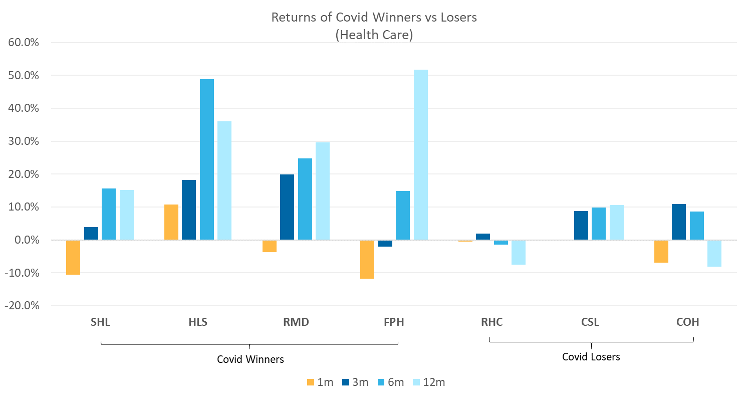The best healthcare investment opportunities for 2021
To understand how professional investors think about healthcare in the current environment, I recently asked three experts where they see the most opportunity in 2021, and beyond.
To say it's not a straightforward sector is an understatement, as opportunities keep pace with broader developments.
Take the prospective vaccine rollout, for example.
One of our trio is currently sifting through those stocks that found COVID upside from the mid-pandemic “losers” that are now tipped to become post-vaccine winners.
And then there's the rise of virtual consultations, with another of our respondents explaining why he believes telehealth is set to take-off, as diagnoses-from-a-distance become an entrenched part of modern medical practice.
In the following wire we hear from:
- Emma Fisher, portfolio manager, Airlie Funds Management
- Chris Kallos, director and life science analyst, MST Access
- Stuart Welch senior research analyst, Alphinity Investment Management
When losers become winners
Emma Fisher, Airlie Funds Management
When predicting “winners” there are two things to consider:
- Earnings – which companies look best placed from 2021 onwards, and
- Valuation – where is that earnings outlook not fully priced in?
When looking at the performance of healthcare stocks through 2020, the results have been stark depending on whether the company was a COVID “winner” or “loser”.

Source: Airlie Research
As shown in the yellow bars above, a few of the perceived winners are starting to give back some performance as vaccines are rolled out and a recovery is expected next year. As always, opportunities from here will be stock-specific, but we are looking more closely at the COVID losers. These are solid businesses that should see an earnings recovery next year and beyond.
Unlike most recovery-sensitive segments of the market, such as travel stocks, the COVID losers haven’t seen huge share price gains in recent months. A business like CSL Limited (ASX: CSL), for example, will benefit from a resumption of normal mobility levels in the US, allowing it to grow collection volumes and reduce donor fees. Meanwhile, it has likely locked in a permanent shift in patient behaviour, as doctors have increasingly prescribed subcutaneous immunogloblin (IG) over intravenous IG because the former can be used in an “at-home” setting.
Patients in the US have wanted to avoid a hospital setting at all costs this year, and CSL makes around US$85 a gram for the sale of subcutaneous IG versus $65-70 a gram for the sale of intravenous IG. This mix shift will likely be permanent because once you get used to a therapy in an at-home setting, you are likely to continue this for the sake of convenience. This underpins revenue growth and margin expansion for the company.
Digital doctoring set for success
Chris Kallos, MST Access
In terms of markets, the US is generally seen as the ultimate goal for any company developing either a drug or medical technology device. And this is the case whether they go directly to the US or via Europe and Asia.
Following on from what I said earlier about biotech, this industry is a feeder to the pharmaceutical industry more generally. For one of the few local examples, CSL is a hybrid biotech and pharmaceutical company.
The other big area that’s prospered this year is digital health, particularly amid lockdowns and social distancing restrictions. This is something that was always on the horizon, but COVID has accelerated adoption by about five years, on average.
Again in the US, the Centers for Medicare and Medicaid Services have brought in new reimbursement codes which mean doctors increasingly will be able to get paid for remote patient monitoring. This is a big area of capital investment in the US.
Where upgrades go, share prices follow
Stuart Welch, Alphinity
At Alphinity we look for undervalued companies in or entering an earnings upgrade cycle. This is because we believe earnings drive share prices: when earnings forecasts are being upgraded, share prices typically follow. So, we invest in companies where consensus earnings forecasts underestimate the earnings power of the business.
On this basis, it is hard to define the best investment opportunities by sectors or markets, it is really a case-by-case basis. We spend most of our time doing stock-specific research to understand the outlook for companies relative to market expectations.
Conclusion
Fund managers hate talking about their portfolios on a top-down, sector-driven basis. And that's understandable because active investing is about buying successful companies, not entire industries. But especially given the health crisis that has dominated 2020, their thoughts on healthcare as an investment sector provide valuable, prescient insights.
The perspective of the non-fundie above is particularly interesting. Given that telehealth stocks have been mentioned by a few top-performing fundies of late, I look forward to seeing how it plays out in the years ahead.
Stay up to date
Don't forget to follow my profile to read the other wires in this three-part series, and give this article a like if you enjoyed it. The first instalment discussed how to find the best healthcare opportunities, and in part three each commentator will reveal a preferred healthcare stock.
3 topics
1 stock mentioned
5 contributors mentioned

